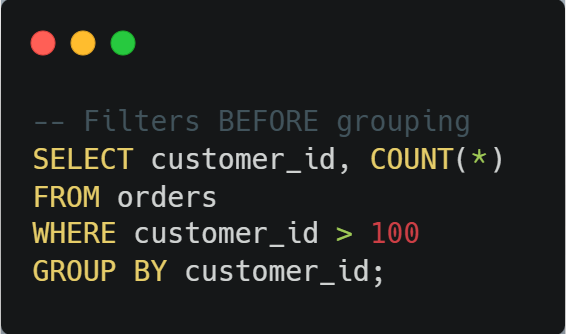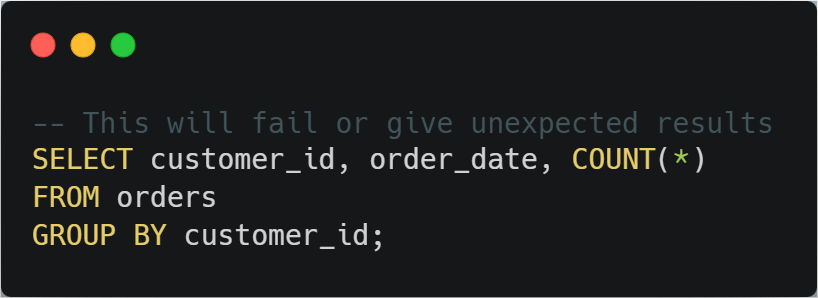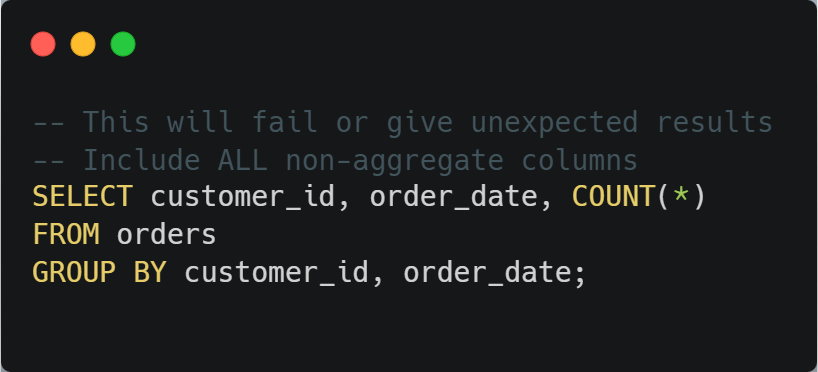Hey Hustlers!
Picture this: You're 20 minutes into a technical interview, feeling confident about your SQL skills. The interviewer asks you to write a query to find customers who haven't made any purchases in the last 6 months. You confidently type away... and then realize your LEFT JOIN just became an INNER JOIN, eliminating exactly the customers you were supposed to find.
Sound familiar?
I've been on both sides of these interviews, and I've seen brilliant analysts stumble on surprisingly simple SQL concepts. The thing is, these aren't knowledge gaps; they're interview pressure mistakes that can make or break your shot at that dream data role.
Today, let's walk through the 7 most common SQL interview mistakes I see (and more importantly, how to avoid them).
1. Jumping into Code Without asking Clarifying Questions
This is the #1 interview killer. You hear "find inactive customers" and immediately start typing, but what defines "inactive"? Last 30 days? 90 days? No purchases ever?
The mistake: Assuming you understand the requirements without asking clarifying questions.
The fix: Always ask: "To make sure I understand correctly, by 'inactive customers' do you mean those with no purchases in the last X months?" Then confirm edge cases.
💡 Pro tip: The top performers? They don't just start coding, they first confirm they're solving the right problem.
2. Not Explaining Your Thought Process
Writing code in silence is like performing surgery without explaining what you're doing to the observing medical students.
The mistake: Typing away quietly, leaving the interviewer guessing about your logic.
The fix: Narrate your approach: "I'm going to use a LEFT JOIN here because we want to keep all customers, even those without recent orders, then filter for NULLs to find the inactive ones."
💡 Pro tip: Explaining your logic often helps you catch mistakes before you make them.
If you're finding these insights helpful, Manisha (Data Science Lead at Google), Siddarth (Senior Director of Data Science at Microsoft), and I dive much deeper into real SQL and Python interview challenges in our weekend Coding Masterclass.
🎁 Just for our subscribers: We're offering 50% off for the next 48 hours, use code "THEDATAHUSTLE" at checkout.
3. Getting your JOINs backwards
Mixing up INNER and LEFT JOINs is like using a scalpel when you need a butter knife.
The mistake: Using INNER JOIN when looking for "customers with no orders" (which by definition requires LEFT JOIN + NULL check).
The fix: Remember the mantra: LEFT JOIN keeps the left table intact, INNER JOIN only keeps matches.
💡 Pro tip: When in doubt, draw it out. Sketch two circles (tables) and shade what you want to keep — it clarifies which JOIN to use instantly.
4. WHERE vs HAVING Confusion
Using HAVING when you should use WHERE is like taking the scenic route during rush hour.
The mistake:
The fix:
💡 Pro tip: Think of WHERE as a bouncer at the door (filters before the party) and HAVING as security inside (filters after the party's started).
5. Ignoring Edge Cases
You write a perfect query for the "happy path" but forget about empty tables, duplicate records, or NULL values lurking in the shadows.
The mistake: Not considering what happens when:
The table is empty
There are duplicate customer IDs
Required fields contain NULL values
Date ranges produce no results
The fix: Always verbalize edge cases: "I should also consider what happens if a customer has multiple orders on the same day" or "I need to handle cases where the join might produce NULLs."
💡 Pro tip: Start every solution with "What could go wrong?" - empty datasets, duplicates, NULLs, and weird dates are your usual suspects.
6. Messing up GROUP BY
Every non-aggregate column in SELECT must be in GROUP BY. Forget this, and some databases will throw errors while others give you random results.
The mistake:
The fix:
💡 Pro tip: If it's in SELECT but not an aggregate function, it must be in GROUP BY. No exceptions, no shortcuts.
7. Mixing up your ranking functions
Confusing RANK() vs ROW_NUMBER() vs DENSE_RANK() is like using the wrong tool from a Swiss Army knife.
ROW_NUMBER(): Always unique (1,2,3,4,5)
RANK(): Ties get same rank, next rank skips (1,2,2,4,5)
DENSE_RANK(): Ties get same rank, no skipping (1,2,2,3,4)
💡 Pro tip: Remember the Olympic medal analogy — DENSE_RANK() gives you Gold(1), Silver(2), Bronze(3) even with ties, while RANK() might skip Bronze if there were two Silvers.
If you're finding these insights helpful, Manisha (Data Science Lead at Google), Siddarth (Senior Director of Data Science at Microsoft), and I dive much deeper into real SQL and Python interview challenges in our weekend Coding Masterclass.
🎁 Just for our subscribers: We're offering 50% off for the next 48 hours, use code "THEDATAHUSTLE" at checkout.
Your Interview Success Kit
Before the interview:
Practice these patterns on real datasets (not just toy examples)
Set up a mental checklist: "NULLs? JOINs? Performance?"
Review the difference between aggregation functions
During the interview:
Talk through your approach before coding
Start with a simple version, then optimize
Always mention edge cases (NULLs, empty results, duplicates)
The secret sauce: Most interviewers care more about your thought process than perfect syntax. Show you're thinking about data quality, performance, and edge cases.
Key Takeaways ✅
Always clarify the question first — ask about definitions, timeframes, and expected edge cases
Think out loud — explain your approach before and while you code
Consider edge cases upfront — empty tables, NULLs, duplicates, and boundary conditions
Choose JOINs intentionally — ask yourself what you want to preserve
Filter early with WHERE — save HAVING for post-aggregation logic
Include all non-aggregate columns in GROUP BY, or use window functions
Know your ranking functions — each has a specific use case
The best Data Analysts and Data Scientists aren't just those who write perfect code, they're the ones who communicate clearly, think systematically about edge cases, and approach problems methodically.
What SQL interview question always trips you up? Hit reply and let me know, I might feature it in a future breakdown!
Best of luck for everything!
- Sai Bysani, a fellow Hustler!
Keep grinding, keep growing,
The Data Hustle.










Clarifying the question is highly underrated. It saves you so much wasted effort.
Summarizes important concepts well !